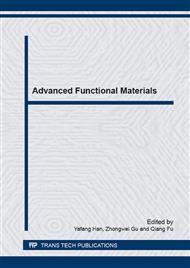p.72
p.76
p.80
p.89
p.97
p.103
p.109
p.115
p.125
Effects of Cobalt Nanoparticles Addition on Shear Strength, Wettability and Interfacial Intermetallic Growth of Sn−3.0Ag−0.5Cu Solder during Thermal Cycling
Abstract:
In the present study, Cobalt nanoparticles were synthesized and mixed with Sn-3.0Ag-0.5Cu solder (SAC305). The effect of 0.05 wt.%, 0.2 wt.%, 0.5 wt.% and 1.0 wt.% Co nanoparticles on the wettability, the shear strength as well as the growth of intermetallic compounds (IMCs) at composite solder/Cu interface during thermal cycling were investigated. Results show that Co nanoparticle addition can considerably improve wettability, increase the shear strength and suppress the growth of interfacial IMCs. The addition amount of Co nanoparticles have the consistent relation with the improvement extent of the wettability, shear strength and the growth rate of interfacial IMCs. Slight addition (0.05 wt.% and 0.2 wt.%) can significantly improve the properties of nanocomposite solder in all the three aspects. However, with excessive addition amount (0.5 wt.% and 1.0 wt.%) of Co nanoparticles, the improvement extent will decline. The Cross-section images of the interface of nanocomposite solder/Cu joint show that Co can form reinforcement particles in the solder and can act as the sacrificial element to substitute Cu to react with Sn. Excessive Co nanoparticles would form large amount of hard and brittle intermetallics which leads to decreasing shear strength of the composite solder.
Info:
Periodical:
Pages:
97-102
Citation:
Online since:
March 2015
Authors:
Price:
Сopyright:
© 2015 Trans Tech Publications Ltd. All Rights Reserved
Share:
Citation:


